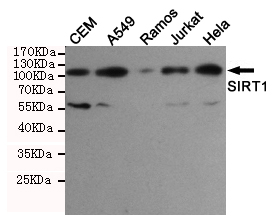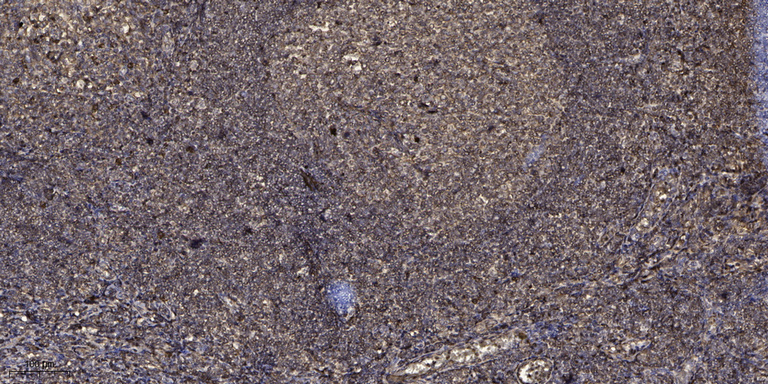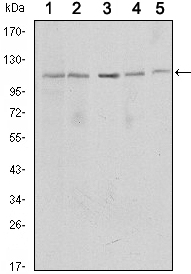SIRT1 Polyclonal Antibody
- Catalog No.:YT4302
- Applications:IF;WB;IHC;ELISA
- Reactivity:Human;Mouse
- Target:
- SIRT1
- Fields:
- >>Nicotinate and nicotinamide metabolism;>>Metabolic pathways;>>FoxO signaling pathway;>>AMPK signaling pathway;>>Longevity regulating pathway;>>Longevity regulating pathway - multiple species;>>Cellular senescence;>>Glucagon signaling pathway;>>Alcoholic liver disease;>>Amphetamine addiction;>>MicroRNAs in cancer
- Gene Name:
- SIRT1
- Protein Name:
- NAD-dependent protein deacetylase sirtuin-1
- Human Gene Id:
- 23411
- Human Swiss Prot No:
- Q96EB6
- Mouse Gene Id:
- 93759
- Mouse Swiss Prot No:
- Q923E4
- Immunogen:
- The antiserum was produced against synthesized peptide derived from human SirT1. AA range:13-62
- Specificity:
- SIRT1 Polyclonal Antibody detects endogenous levels of SIRT1 protein.
- Formulation:
- Liquid in PBS containing 50% glycerol, 0.5% BSA and 0.02% sodium azide.
- Source:
- Polyclonal, Rabbit,IgG
- Dilution:
- IF 1:50-200 WB 1:500 - 1:2000. IHC 1:100 - 1:300. ELISA: 1:5000. Not yet tested in other applications.
- Purification:
- The antibody was affinity-purified from rabbit antiserum by affinity-chromatography using epitope-specific immunogen.
- Concentration:
- 1 mg/ml
- Storage Stability:
- -15°C to -25°C/1 year(Do not lower than -25°C)
- Other Name:
- SIRT1;SIR2L1;NAD-dependent protein deacetylase sirtuin-1;hSIRT1;Regulatory protein SIR2 homolog 1;SIR2-like protein 1;hSIR2
- Observed Band(KD):
- 85-110kD
- Background:
- This gene encodes a member of the sirtuin family of proteins, homologs to the yeast Sir2 protein. Members of the sirtuin family are characterized by a sirtuin core domain and grouped into four classes. The functions of human sirtuins have not yet been determined; however, yeast sirtuin proteins are known to regulate epigenetic gene silencing and suppress recombination of rDNA. Studies suggest that the human sirtuins may function as intracellular regulatory proteins with mono-ADP-ribosyltransferase activity. The protein encoded by this gene is included in class I of the sirtuin family. Alternative splicing results in multiple transcript variants. [provided by RefSeq, Dec 2008],
- Function:
- catalytic activity:NAD(+) + an acetylprotein = nicotinamide + O-acetyl-ADP-ribose + a protein.,cofactor:Binds 1 zinc ion per subunit.,enzyme regulation:Inhibited by nicotinamide. Activated by resveratrol (3,5,4'-trihydroxy-trans-stilbene), butein (3,4,2',4'-tetrahydroxychalcone), piceatannol (3,5,3',4'-tetrahydroxy-trans-stilbene), Isoliquiritigenin (4,2',4'-trihydroxychalcone), fisetin (3,7,3',4'-tetrahydroxyflavone) and quercetin (3,5,7,3',4'-pentahydroxyflavone). RPS19BP1/AROS acts as a positive regulator of deacetylation activity.,function:NAD-dependent deacetylase, which regulates processes such as apoptosis and muscle differentiation by deacetylating key proteins. Deacetylates 'Lys-382' of p53/TP53 and impairs its ability to induce proapoptotic program and modulate cell senescence. Deacetylates TAF1B and thereby represses rDNA transcription by the RNA polymerase I. Involved in HES1
- Subcellular Location:
- Nucleus, PML body . Cytoplasm . Nucleus . Recruited to the nuclear bodies via its interaction with PML (PubMed:12006491). Colocalized with APEX1 in the nucleus (PubMed:19934257). May be found in nucleolus, nuclear euchromatin, heterochromatin and inner membrane (PubMed:15469825). Shuttles between nucleus and cytoplasm (By similarity). Colocalizes in the nucleus with XBP1 isoform 2 (PubMed:20955178). .; [SirtT1 75 kDa fragment]: Cytoplasm . Mitochondrion .
- Expression:
- Widely expressed.
CD38 affects the biological behavior and energy metabolism of nasopharyngeal carcinoma cells. INTERNATIONAL JOURNAL OF ONCOLOGY Int J Oncol. 2019 Feb;54(2):585-599 WB Human 1:1000 5-8F cell
Gut-Flora-Dependent Metabolite Trimethylamine-N-Oxide Promotes Atherosclerosis-Associated Inflammation Responses by Indirect ROS Stimulation and Signaling Involving AMPK and SIRT1 Nutrients Wenjian Ma WB Human
Melatonin alleviates doxorubicin-induced cardiotoxicity via inhibiting oxidative stress, pyroptosis and apoptosis by activating Sirt1/Nrf2 pathway BIOMEDICINE & PHARMACOTHERAPY Congxin Huang WB Rat,Mouse heart H9C2 cell
m6A-Dependent Modulation via IGF2BP3/MCM5/Notch Axis Promotes Partial EMT and LUAD Metastasis. Junchao Cai WB Human A549 cell,HEK293FT cell
Placenta-derived exosomal miR-135a-5p promotes gestational diabetes mellitus pathogenesis by activating PI3K/AKT signalling pathway via SIRT1. JOURNAL OF CELLULAR AND MOLECULAR MEDICINE Jianying Yan WB Human placenta tissue HTR-8/SVneo cell
Alternate-day fasting ameliorated anxiety-like behavior in high-fat diet-induced obese mice JOURNAL OF NUTRITIONAL BIOCHEMISTRY Huijuan Hu WB Mouse 1:1000 hippocampal tissue
- June 19-2018
- WESTERN IMMUNOBLOTTING PROTOCOL
- June 19-2018
- IMMUNOHISTOCHEMISTRY-PARAFFIN PROTOCOL
- June 19-2018
- IMMUNOFLUORESCENCE PROTOCOL
- September 08-2020
- FLOW-CYTOMEYRT-PROTOCOL
- May 20-2022
- Cell-Based ELISA│解您多样本WB检测之困扰
- July 13-2018
- CELL-BASED-ELISA-PROTOCOL-FOR-ACETYL-PROTEIN
- July 13-2018
- CELL-BASED-ELISA-PROTOCOL-FOR-PHOSPHO-PROTEIN
- July 13-2018
- Antibody-FAQs
- Products Images
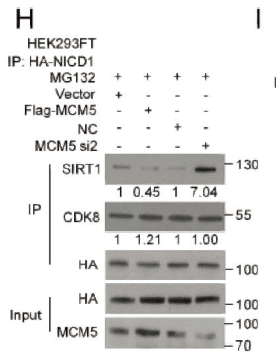
- m6A-Dependent Modulation via IGF2BP3/MCM5/Notch Axis Promotes Partial EMT and LUAD Metastasis. Junchao Cai IHC,IF Human 1:200 lung adenocarcinoma (LUAD) tissue A549 cell,H1975 cell
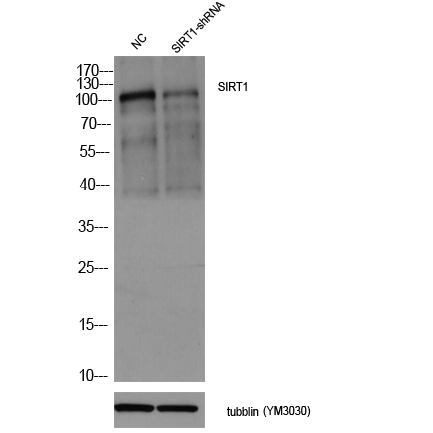
- Western blot analysis of lysates from 1)Mouse Ovarian granulosa cell , 2)Mouse Ovarian granulosa cell knockdown by SIRT1-siRNA, primary antibody was diluted at 1:1000, 4°over night, secondary antibody(Immunoway:RS0002)was diluted at 1:10000, 37° 1hour. β-Tubulin Monoclonal Antibody(5G3) (Immunoway:YM3030) antibody was diluted at 1:5000 as loading control, 4° over night, secondary antibody(Immunoway:RS0001)was diluted at 1:10000, 37° 1hour.
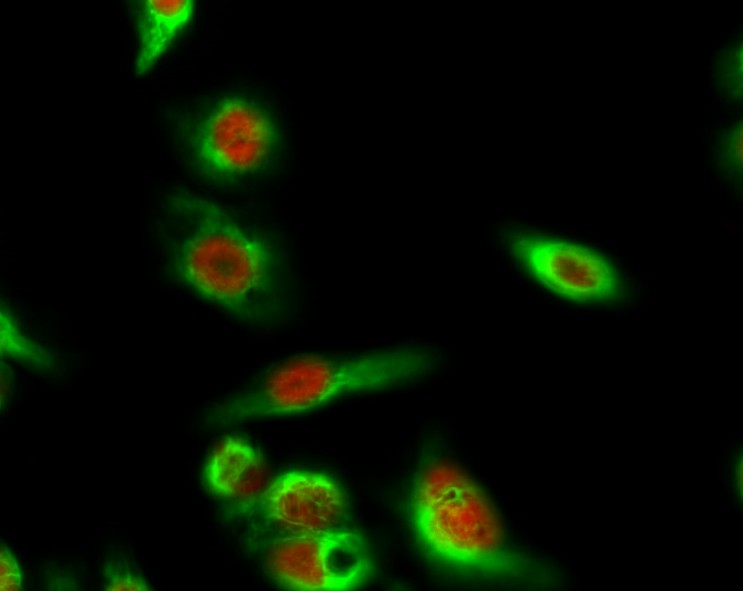
- Immunofluorescence analysis of Hela cell. 1,SIRT1 Polyclonal Antibody(red) was diluted at 1:200(4° overnight). LC3B Polyclonal Antibody(green) was diluted at 1:200(4° overnight). 2, Goat Anti Rabbit Alexa Fluor 594 Catalog:RS3611 was diluted at 1:1000(room temperature, 50min). Goat Anti Mouse Alexa Fluor 488 Catalog:RS3208 was diluted at 1:1000(room temperature, 50min).
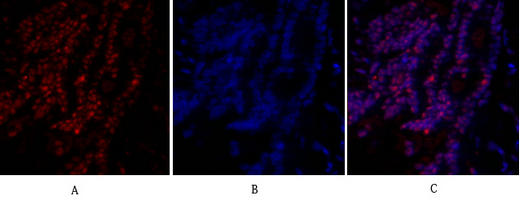
- Immunofluorescence analysis of rat-lung tissue. 1,SIRT1 Polyclonal Antibody(red) was diluted at 1:200(4°C,overnight). 2, Cy3 labled Secondary antibody was diluted at 1:300(room temperature, 50min).3, Picture B: DAPI(blue) 10min. Picture A:Target. Picture B: DAPI. Picture C: merge of A+B
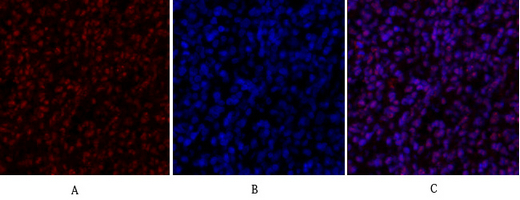
- Immunofluorescence analysis of rat-spleen tissue. 1,SIRT1 Polyclonal Antibody(red) was diluted at 1:200(4°C,overnight). 2, Cy3 labled Secondary antibody was diluted at 1:300(room temperature, 50min).3, Picture B: DAPI(blue) 10min. Picture A:Target. Picture B: DAPI. Picture C: merge of A+B
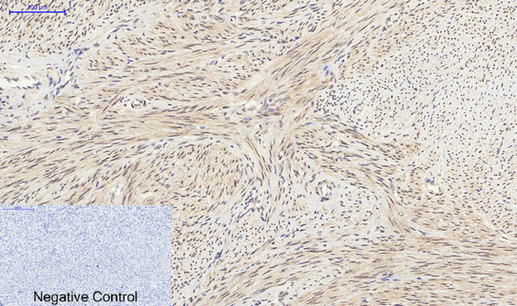
- Immunohistochemical analysis of paraffin-embedded Human-uterus tissue. 1,SIRT1 Polyclonal Antibody was diluted at 1:200(4°C,overnight). 2, Sodium citrate pH 6.0 was used for antibody retrieval(>98°C,20min). 3,Secondary antibody was diluted at 1:200(room tempeRature, 30min). Negative control was used by secondary antibody only.
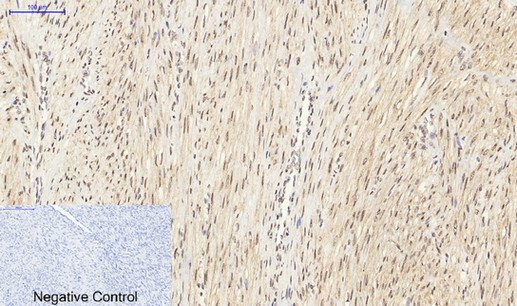
- Immunohistochemical analysis of paraffin-embedded Human-uterus-cancer tissue. 1,SIRT1 Polyclonal Antibody was diluted at 1:200(4°C,overnight). 2, Sodium citrate pH 6.0 was used for antibody retrieval(>98°C,20min). 3,Secondary antibody was diluted at 1:200(room tempeRature, 30min). Negative control was used by secondary antibody only.

- Immunohistochemical analysis of paraffin-embedded Human-colon tissue. 1,SIRT1 Polyclonal Antibody was diluted at 1:200(4°C,overnight). 2, Sodium citrate pH 6.0 was used for antibody retrieval(>98°C,20min). 3,Secondary antibody was diluted at 1:200(room tempeRature, 30min). Negative control was used by secondary antibody only.
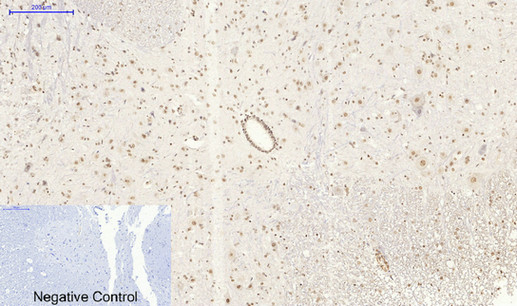
- Immunohistochemical analysis of paraffin-embedded Rat-spinal-cord tissue. 1,SIRT1 Polyclonal Antibody was diluted at 1:200(4°C,overnight). 2, Sodium citrate pH 6.0 was used for antibody retrieval(>98°C,20min). 3,Secondary antibody was diluted at 1:200(room tempeRature, 30min). Negative control was used by secondary antibody only.

- Immunohistochemical analysis of paraffin-embedded Rat-brain tissue. 1,SIRT1 Polyclonal Antibody was diluted at 1:200(4°C,overnight). 2, Sodium citrate pH 6.0 was used for antibody retrieval(>98°C,20min). 3,Secondary antibody was diluted at 1:200(room tempeRature, 30min). Negative control was used by secondary antibody only.
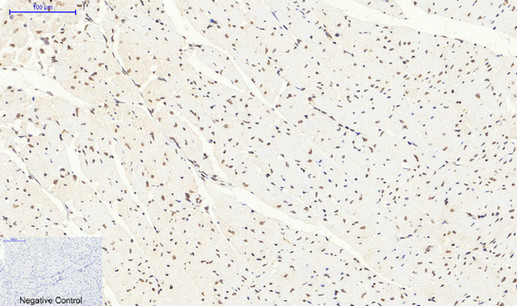
- Immunohistochemical analysis of paraffin-embedded Mouse-heart tissue. 1,SIRT1 Polyclonal Antibody was diluted at 1:200(4°C,overnight). 2, Sodium citrate pH 6.0 was used for antibody retrieval(>98°C,20min). 3,Secondary antibody was diluted at 1:200(room tempeRature, 30min). Negative control was used by secondary antibody only.
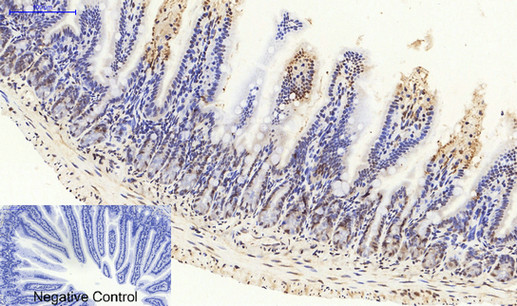
- Immunohistochemical analysis of paraffin-embedded Mouse-colon tissue. 1,SIRT1 Polyclonal Antibody was diluted at 1:200(4°C,overnight). 2, Sodium citrate pH 6.0 was used for antibody retrieval(>98°C,20min). 3,Secondary antibody was diluted at 1:200(room tempeRature, 30min). Negative control was used by secondary antibody only.
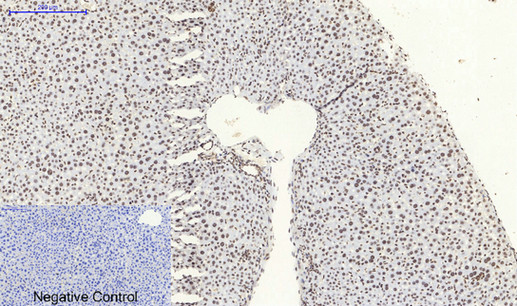
- Immunohistochemical analysis of paraffin-embedded Mouse-liver tissue. 1,SIRT1 Polyclonal Antibody was diluted at 1:200(4°C,overnight). 2, Sodium citrate pH 6.0 was used for antibody retrieval(>98°C,20min). 3,Secondary antibody was diluted at 1:200(room tempeRature, 30min). Negative control was used by secondary antibody only.
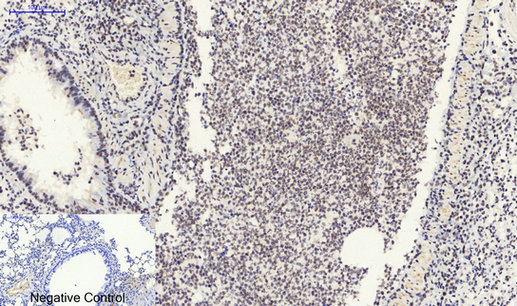
- Immunohistochemical analysis of paraffin-embedded Mouse-lung tissue. 1,SIRT1 Polyclonal Antibody was diluted at 1:200(4°C,overnight). 2, Sodium citrate pH 6.0 was used for antibody retrieval(>98°C,20min). 3,Secondary antibody was diluted at 1:200(room tempeRature, 30min). Negative control was used by secondary antibody only.
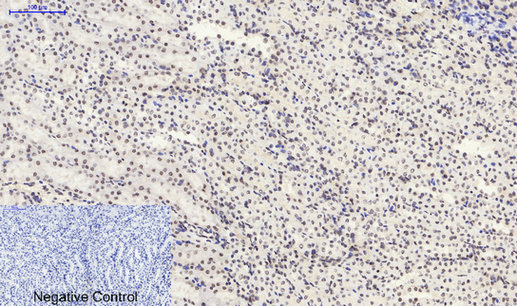
- Immunohistochemical analysis of paraffin-embedded Mouse-kidney tissue. 1,SIRT1 Polyclonal Antibody was diluted at 1:200(4°C,overnight). 2, Sodium citrate pH 6.0 was used for antibody retrieval(>98°C,20min). 3,Secondary antibody was diluted at 1:200(room tempeRature, 30min). Negative control was used by secondary antibody only.

- Immunohistochemical analysis of paraffin-embedded Mouse-brain tissue. 1,SIRT1 Polyclonal Antibody was diluted at 1:200(4°C,overnight). 2, Sodium citrate pH 6.0 was used for antibody retrieval(>98°C,20min). 3,Secondary antibody was diluted at 1:200(room tempeRature, 30min). Negative control was used by secondary antibody only.
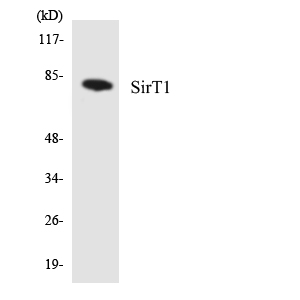
- Western blot analysis of the lysates from COLO205 cells using SirT1 antibody.
